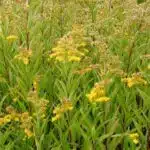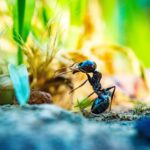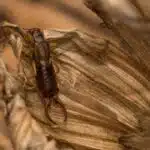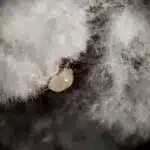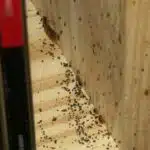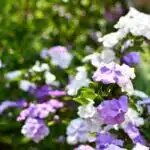Aphids are a common pest that can cause significant damage to crops and garden plants. They are small, soft-bodied insects that feed by sucking sap from plant leaves, stems, and flowers. Aphids are prolific breeders and can quickly infest a plant if left unchecked. Identifying and controlling aphids is essential for preventing crop loss and maintaining healthy gardens.
As a pest control specialist, it is crucial to have a comprehensive understanding of the biology and behavior of aphids. This knowledge enables us to develop effective strategies for managing their populations. In this article, we will explore the various methods for identifying aphids, including physical characteristics, host plants, and symptoms of infestation. We will also discuss the most effective ways to control aphid populations using both chemical and non-chemical methods. By understanding these key concepts, you will be equipped with the tools necessary to identify and manage aphids effectively.
Overview Of Aphids And Their Impact On Plants
Aphids are tiny, soft-bodied insects that belong to the family Aphididae. They are commonly known as plant lice and feed on a wide range of plants by piercing the leaves, stems, and other plant parts with their needle-like mouthparts. Aphids reproduce rapidly and can cause significant damage to crops by transmitting viruses, reducing photosynthesis rates, and causing deformities in plant growth.
Identifying aphid predators is an important part of controlling aphid populations. Some common natural enemies of aphids include ladybugs, lacewings, syrphid flies, and parasitic wasps that lay eggs inside aphids. These predators help keep aphid populations in check by feeding on them or using them as hosts for their offspring. Additionally, planting flowers such as marigolds or herbs like dill can attract these beneficial insects to your garden and reduce the likelihood of a severe infestation.
The impact of aphids on crop yield can be devastating if left unchecked. The loss of plant vigor due to nutrient depletion caused by aphids can lead to stunted growth and even death in extreme cases. In addition to impacting crop yield directly, aphids also transmit viruses that can cause further damage to plants. It is important for farmers and gardeners alike to understand the threat that aphids pose to their crops and take proactive measures to control their populations before they become too large to handle.
Understanding the physical characteristics of aphids is essential when attempting to effectively control their populations. From their small size (ranging from 1-10mm) and elongated shape to their antennae and cornicles (small tubular structures on the abdomen), each aspect plays a critical role in identifying specific species of aphids. By understanding what makes these pests tick at a fundamental level, those tasked with controlling them will be better equipped both mentally and physically when it comes time for action.
Physical Characteristics Of Aphids
Aphids are small, soft-bodied insects that feed on plants by sucking sap. They are one of the most common pests in gardens and agricultural fields worldwide. Aphids have a complex life cycle with several different stages, including egg, nymph, and adult. During the nymph and adult stages, aphids use their needle-like mouthparts to pierce plant tissue and extract sap.
Morphological adaptations allow aphids to feed on plants more efficiently. For example, their mouthparts are long and slender, allowing them to penetrate deep into plant tissue. Aphids also have tube-like structures called stylets that help them suck sap from plants more easily. Additionally, color variation among aphid species can provide camouflage or warning signals against predators.
Feeding behavior varies between aphid species. Some feed only on specific plant species or parts of plants, while others are generalists that will feed on any available plant material. Some species produce honeydew as they feed, which is a sweet liquid that attracts ants and other insects.
Understanding the physical characteristics of aphids is crucial for identifying and controlling these pests effectively. In the subsequent section, we will discuss common host plants for aphids and how to manage infestations using both cultural and chemical control methods.
Common Host Plants For Aphids
Identification and prevention of common host plants is essential in controlling aphid infestations. Aphids are known to feed on a variety of plants, including fruits, vegetables, and ornamental plants. In identifying the common host plants for aphids, it is important to note that they prefer succulent growth or new plant tissues.
The impact of aphids on crop yields can be devastating. They cause stunted growth, wilting, and yellowing of leaves, which can lead to reduced photosynthesis and ultimately decreased yield. To prevent this from happening, farmers should take proactive measures such as monitoring their crops regularly for signs of infestation and removing any affected plants immediately.
Here are the three most common host plants for aphids:
Roses – Aphids are commonly found on rose bushes because they provide an ideal environment for their reproduction. The soft new growth of roses provides an excellent food source for these pests.
Tomatoes – Aphids can cause significant damage to tomato plants by feeding on the leaves and stems. This can result in leaf drop, stunted growth, and reduced fruit yield.
Beans – Bean plants attract aphids due to their tender young leaves and stems. Infested beans often have distorted or curled leaves, which can lead to reduced yields if not addressed promptly.
By knowing the common host plants for aphids and taking preventive measures early on in the growing season, farmers can avoid potential crop losses caused by these pests. In the next section, we will discuss symptoms of aphid infestations that farmers should look out for when monitoring their crops closely.
Symptoms Of Aphid Infestation
Identifying aphid species is crucial to controlling their infestation and preventing further damage. Aphids come in various colors ranging from green, yellow, black, brown, or pink. They also have different shapes and sizes depending on the species. Some have a pear-shaped body while others are oval or elongated. Identifying their species will help determine the appropriate control method to use.
Early detection methods are essential in preventing severe damage caused by aphids. One of the earliest signs of an aphid infestation is the curling of leaves accompanied by sticky honeydew secretion on the plant’s surface. The presence of ants around the plant is another indication of an aphid infestation since they feed on honeydew excreted by aphids. Inspecting plants regularly for these symptoms can help detect and control an infestation before it becomes too severe.
In conclusion, identifying aphid species and early detection methods are vital in controlling their infestation before they cause significant damage to plants. Regular inspection and monitoring of plants can help detect an infestation early enough to prevent further spread. Understanding aphid biology and behavior is also essential in developing effective control measures that target specific species without harming beneficial insects or other organisms that play a crucial role in maintaining a balanced ecosystem.
Understanding Aphid Biology And Behavior
Aphids are one of the most common pests that gardeners and farmers have to deal with. They feed on a wide range of plants, including many important crops, and can cause significant damage if left unchecked. In fact, it is estimated that aphids cause billions of dollars in crop losses each year worldwide.
Understanding aphid biology and behavior is essential for effective pest management. Aphids are small insects that use their piercing-sucking mouthparts to feed on plant sap. They typically feed on the undersides of leaves or at the growing tips of plants, where the plant tissue is most succulent. Their feeding behavior can cause stunted growth, wilting, yellowing or curling of leaves, and reduced crop yields.
Environmental factors such as temperature, humidity, and host plant quality can affect aphid populations. Warmer temperatures generally lead to higher rates of reproduction and shorter development times for nymphs. High humidity levels can also be beneficial for aphids since it reduces water stress on host plants. Additionally, plant quality plays an important role in aphid populations since they prefer to feed on plants with high nitrogen content. By understanding these factors, pest control specialists can develop effective strategies to manage aphid infestations without resorting to chemical control methods.
Moving forward from understanding the biology and behavior of aphids, controlling them using chemical methods may be necessary in some cases. There are several options available for chemical control methods that target different stages in the life cycle of an aphid. These include insecticidal soaps which work by disrupting the cell membranes of insects; neonicotinoids which interfere with nerve function; and pyrethroids which affect sodium channels in nerve cells causing paralysis and death. However, before resorting to these methods it is important to consider environmental impacts and potential harm to non-target organisms such as pollinators or natural predators of aphids like ladybugs or lacewings.
Chemical Control Methods For Aphids
Synthetic insecticides are chemical compounds often used to control aphids in agricultural settings due to their ability to quickly reduce pest populations. Common synthetic insecticides used against aphids include neonicotinoids, organophosphates, and pyrethroids. Organic insecticides, such as neem oil, can provide a safe alternative to synthetic insecticides and are often derived from naturally occurring compounds. Biological control agents, such as ladybugs and lacewings, are also effective against aphids, as they feed on the pest and disrupt its reproductive cycle. Beneficial nematodes have also been used to control aphid populations by infecting the pests with bacteria that are fatal to them. In summary, a variety of chemical, organic and biological control methods can be used to control aphid infestations.
Synthetic Insecticides
Synthetic insecticides are chemical control methods that have been widely used to manage aphids. These products contain active ingredients that are toxic to the pests, causing them harm or death upon contact or ingestion. The use of synthetic insecticides in controlling aphids has proven effective as it is a quick and easy solution to eliminate large infestations. However, environmental impact is a major concern due to the potential accumulation of residues in soil and water sources.
Environmental impact resulting from synthetic insecticide use is a significant issue that cannot be overlooked. These products may persist for an extended period after application, leading to contamination of soil and water sources. This contamination can be harmful to non-target organisms such as pollinators and aquatic life forms. Additionally, the excessive use of these chemicals may lead to resistance development among aphids, making control efforts more challenging in the long run.
Resistance development is another critical factor in the use of synthetic insecticides against aphids. Over time, frequent exposure to these chemicals can cause genetic changes within pest populations leading to resistance against conventional control methods. This resistance can be passed on from generation to generation, making it increasingly difficult for pest management specialists to control aphid populations using synthetic insecticides. Thus, it is essential to implement integrated pest management strategies that incorporate alternative methods such as biological control agents and cultural practices alongside chemical controls.
In conclusion, while synthetic insecticides remain a popular option for controlling aphids due to their quick results, they are not without their concerns. The environmental impact resulting from their use and resistance development among pest populations necessitate caution when utilizing these products as part of an integrated pest management strategy. Pest management specialists must strike a balance between effectiveness and sustainability in controlling aphid infestations while avoiding negative impacts on the environment and non-target organisms.
Organic Insecticides
Chemical control methods for aphids have been widely used to manage infestations. However, the environmental impact and resistance development among pest populations resulting from the use of synthetic insecticides necessitate alternative approaches. Organic insecticides are an option that can be considered in controlling aphids.
Organic insecticides are derived from natural sources and may include plant extracts, botanical oils, and microorganisms. These products offer a safer alternative to synthetic insecticides as they do not persist in the environment or cause harm to non-target organisms. Additionally, organic insecticides may provide a more sustainable approach to pest management as they are biodegradable and may be less likely to lead to resistance development among pest populations.
While DIY insecticides made from household items such as soap or vinegar have been touted as effective against aphids, their efficacy compared to commercially available organic insecticides remains uncertain. It is crucial to evaluate the effectiveness of homemade remedies before employing them as a control method. Pest management specialists must also consider the safety of these DIY options, especially concerning potential human exposure during application and handling. Overall, organic insecticides present a viable option in controlling aphid infestations while minimizing negative impacts on the environment and non-target organisms.
Biological Control Agents
Chemical control methods have been widely used to manage aphid infestations, but their environmental impact and resistance development among pest populations necessitate alternative approaches. Organic insecticides may provide a safer and more sustainable option for controlling aphids as they are derived from natural sources and biodegradable. However, the efficacy of homemade remedies compared to commercially available organic insecticides remains uncertain, and their safety during application and handling must be considered.
Biological control agents offer another alternative to chemical methods in managing aphids. These agents use natural enemies such as predators or parasitoids to control pest populations. The use of biological control has increased in recent years due to its potential efficacy against pests while minimizing negative impacts on the environment and non-target organisms.
Biological control efficacy can be optimized through release timing, which depends on factors such as pest density, weather conditions, and natural enemy availability. For example, releasing predators before aphid populations reach high levels can prevent infestations from becoming severe. Pest management specialists must also consider the compatibility of biological control agents with other management practices such as organic insecticides or cultural practices to maximize their effectiveness. Biological control presents a promising option for controlling aphids that should be integrated into an overall pest management strategy.
Non-Chemical Control Methods For Aphids
As a pest control specialist, I have seen the damage that aphids can cause in gardens and crops. However, there are non-chemical methods that can be used to control aphid infestations. Companion planting is one such method. By planting certain plants alongside others, you can attract beneficial insects that will prey on aphids. For example, planting marigolds with tomatoes or peppers can attract ladybugs that will eat the aphids.
Another non-chemical method for controlling aphids is horticultural oils. Horticultural oils are derived from petroleum or plant-based sources and are sprayed directly onto the plants to suffocate the aphids. The oil works by coating the insect’s body and blocking its spiracles, which it uses to breathe. Horticultural oils should be applied to plants when temperatures are between 40 and 90 degrees Fahrenheit and should not be used during periods of drought or high heat.
In addition to companion planting and horticultural oils, there are other non-chemical methods for controlling aphids, such as using reflective mulches or reflective sticky traps. These methods work by disorienting the aphids and preventing them from finding their target plants. Additionally, physical removal of aphid-infested leaves or stems can also help reduce populations. By using these non-chemical methods in combination with each other, you can effectively control an aphid infestation without resorting to chemical pesticides.
Transition: While non-chemical methods may be effective in controlling small-scale infestations of aphids, larger-scale infestations may require a more integrated approach to pest management strategies.
Integrated Pest Management Strategies For Aphids
Biological control of aphids involves the use of natural predators, such as ladybugs and lacewings, to reduce aphid populations. Cultural control strategies for aphids include crop rotation to reduce the risk of reinfestation, pruning and weeding to reduce aphid habitats, and mulching to prevent reproduction and spread. Chemical control of aphids may involve insecticidal soaps, neem oil, or insecticides, depending on the severity of the infestation. Monitoring of aphids is essential to the successful implementation of an integrated pest management strategy, and should include regularly inspecting for signs of infestation, as well as planting resistant varieties, covering rows of crops with row covers, and encouraging beneficial insects by implementing sanitation measures.
Biological Control
As pest control specialists, we understand the importance of biological control in managing aphids. This strategy involves the use of natural enemies to reduce aphid populations, which can be more sustainable and less harmful to the environment than chemical pesticides. The pros of biological control include long-term effectiveness, low cost, and minimal impact on non-target organisms.
One effective method of biological control is introducing predator insects such as ladybugs, lacewings, and hoverflies that feed on aphids. These predators can be released into infested areas and will naturally regulate the aphid population by consuming them. Another method is using parasitic wasps that lay their eggs inside aphids, which eventually kills them. However, a potential con of biological control is that it may not always result in complete eradication of aphids since some species may have developed resistance to certain predators or parasites.
Overall, integrating biological control into an integrated pest management strategy for aphids can effectively reduce populations while minimizing negative impacts on the environment. By utilizing natural enemies and understanding their limitations, we can create a sustainable approach to managing these pests without relying solely on chemical pesticides. Our goal as pest control specialists is to provide effective solutions while also prioritizing the health and safety of our clients and their surroundings.
Cultural Control
As pest control specialists, we recognize the importance of implementing multiple strategies in managing aphids. In addition to biological control, cultural control is another method that can be used to prevent and reduce aphid infestations without relying on chemical pesticides. Cultural control involves altering the environment or practices to make it less favorable for aphids to thrive.
One effective cultural control method is companion planting, which involves growing plants that complement each other and deter pests. For instance, planting garlic or onions near a crop of lettuce can repel aphids due to their strong odor. Similarly, marigolds can be planted around vegetable gardens as they release a chemical that repels aphids. Another method is crop rotation, where different crops are planted in different areas each season to break the life cycle of pests such as aphids.
Implementing cultural control measures requires careful planning and consideration of various factors such as soil quality and climate conditions. It may also require experimentation with different plant combinations and rotations to determine what works best for specific environments. By integrating cultural control into an integrated pest management strategy for aphids, we can provide our clients with effective solutions while promoting sustainable practices that benefit both the environment and their crops.
Prevention Measures For Aphids
As the saying goes, prevention is better than cure. This holds true for aphids as well. Instead of waiting for an infestation to occur, it is better to take preventive measures beforehand. There are various ways to control aphids before they become a problem.
One effective method of preventing aphid infestations is companion planting. Certain plants attract insects that prey on aphids and keep them in check. For example, planting marigolds, mint, and chives with vegetables such as tomatoes, peppers, and eggplants can help repel aphids. Additionally, intercropping with plants like garlic and onions can deter aphids from attacking your crops.
Soil management is another crucial aspect of preventing aphid infestations. Soil fertility plays a vital role in plant growth and health, which ultimately affects their resistance to pests like aphids. Ensure that the soil is well-draining and has adequate nutrients to support healthy plant growth. Avoid over-fertilization as it can lead to excessive growth that may attract pests.
- Follow these five tips for effective prevention of aphid infestations:
- Regularly inspect your plants for signs of pest damage.
- Remove any weeds or diseased plants from your garden.
- Use organic fertilizers instead of chemical ones.
- Mulch around your plants to retain moisture and prevent weed growth.
- Use row covers or netting to protect your plants from flying insects.
Taking preventive measures against aphids is essential in maintaining a healthy garden. By implementing companion planting techniques and managing soil health, you can minimize the risk of an infestation occurring. However, even with preventive measures in place, it’s still important to monitor your plants regularly for any signs of pest damage. In the next section, we will discuss how beneficial insects can be used to control aphids without harmful chemicals or pesticides.
Beneficial Insects That Control Aphids
As discussed in the previous section, prevention measures are essential to control aphids. However, when infestation occurs, beneficial insects can serve as a natural solution to eliminate these pests. We will explore some of these insects and how they can help control aphids.
Ladybugs, also known as lady beetles or ladybird beetles, are one of the most common beneficial insects used for controlling aphids. A single ladybug can consume up to 50 aphids a day. Furthermore, their larvae are even more voracious and can consume hundreds of aphids during their development stage. Other beneficial insects that prey on aphids include lacewings, hoverflies, and parasitic wasps.
Attracting pollinators through companion planting is another effective method for controlling aphid populations. Planting flowers such as marigolds, zinnias, and sunflowers alongside vegetable crops attract pollinators like bees and butterflies which also feed on nectar-producing plants that grow in tandem with these flowers. This helps create a diverse ecosystem in your garden which reduces the chances of an aphid infestation by balancing out the insect population.
Transitioning into our next topic of natural aphid repellents, it is important to note that while beneficial insects are an excellent solution for controlling aphids, they may not always be sufficient in eliminating them completely. There are other natural methods available that work well in conjunction with beneficial insects to keep your garden free from pests without using harmful chemicals or pesticides.
Natural Aphid Repellents
Aphids are one of the most common pests that can be found in gardens and farms. They are small, sap-sucking insects that damage plants by draining their nutrients and spreading diseases. Although there are many chemical pesticides available in the market to control aphids, they can be harmful to humans, pets, and beneficial insects. Therefore, it is best to use natural repellents to keep these pests at bay.
One effective way to repel aphids naturally is through companion planting. This technique involves growing two or more plants together that benefit each other by repelling pests or attracting beneficial insects. For example, planting garlic or chives with lettuce or tomatoes can deter aphids while attracting ladybugs and lacewings that feed on them. Similarly, marigolds emit a scent that repels aphids while attracting hoverflies that prey on them.
Another natural method of controlling aphids is by using DIY recipes made from household ingredients. These homemade remedies not only repel aphids but also nourish the plants without causing any harm to the environment. For instance, a mixture of water, dish soap, and vegetable oil sprayed on the affected plants can suffocate the aphids and prevent further infestation. Similarly, spraying a solution of neem oil and water can disrupt their reproductive cycle and weaken their immune system.
In conclusion, natural repellents such as companion planting and DIY recipes are effective ways of controlling aphids without harming the environment. By incorporating these methods into your gardening routine, you can protect your plants from damage caused by these pests while promoting a healthy ecosystem. In the next section, we will discuss another natural method for controlling aphids- using traps.
Using Traps To Control Aphids
Having discussed natural aphid repellents in the previous section, it is now time to delve into the use of traps as another method of controlling aphids. DIY traps are an effective and affordable way to monitor and reduce the number of aphids in your garden or farm. These traps work by attracting aphids with a bait that they find irresistible, such as sugar water or apple cider vinegar.
When using DIY traps, proper placement is crucial. It is important to place the trap near the plant that is infested with aphids, and also close to where they are congregating. Traps can be hung from branches or placed on stakes near the plant. It is important to regularly check and empty the trap, as leaving it full for too long may attract more pests than it catches.
By using DIY traps strategically, you can greatly reduce the number of aphids in your garden or farm without harming other beneficial insects or plants. Understanding where and when to place these traps is key in their effectiveness. In the next section, we will discuss how understanding the life cycle of aphids can further aid in controlling their population.
Understanding The Life Cycle Of Aphids
Aphids reproduce quickly and can have multiple generations in a single year. They feed on plant sap and can cause damage to crops and ornamentals. Predators of aphids include lady beetles, lacewings, and hoverflies. Chemical control strategies are also available for managing aphid populations. Understanding the life cycle of aphids is key to identifying and controlling them. Population monitoring of aphids is recommended to identify when control strategies need to be implemented.
Reproduction
Aphids are notorious pests that can evoke anxiety and frustration in gardeners and farmers alike. Understanding the life cycle of aphids is crucial for effective pest control. One important aspect of this life cycle is their reproduction. Aphids have unique mating behavior, which involves males injecting sperm directly into females through a needle-like structure called the aedeagus. This process, known as traumatic insemination, can damage the female’s reproductive organs. Despite this, female aphids are capable of producing offspring without mating through a process called parthenogenesis.
Environmental factors such as temperature and humidity play a significant role in aphid reproduction. Temperature influences the development time of offspring; warmer temperatures result in faster development times and an increase in the number of generations produced per year. High humidity also promotes rapid reproduction rates by providing suitable conditions for aphid egg hatching and nymph growth. Conversely, low humidity levels can decrease survival rates of adult aphids, reducing overall reproductive success.
Controlling aphid populations requires knowledge of their reproductive behavior and environmental requirements. By understanding these factors, pest control specialists can implement measures to disrupt mating behavior or manipulate environmental conditions to reduce reproduction rates. Effective management strategies include using natural predators or introducing biological controls such as parasitic wasps, which target aphid eggs and nymphs before they reach maturity. In summary, understanding aphids’ unique mating behavior and environmental needs is essential for successful pest control management practices that minimize damage to crops while preserving beneficial insects’ health in gardens and farms alike.
Feeding Habits
Understanding the life cycle of aphids is essential for effective pest control management practices. Alongside their unique mating behavior and environmental needs, it is also crucial to have knowledge about the feeding habits of these notorious pests. Aphids are sap-sucking insects that feed on the phloem sap of plants. They use their stylet-like mouthparts to pierce through plant tissues and extract plant fluids.
Aphids’ feeding patterns can cause significant damage to plants, particularly during early growth stages when they are most vulnerable. As aphids suck the sap from plants, they introduce toxic saliva into the host’s system, leading to distorted leaves and stunted growth. Moreover, as they consume vast amounts of plant fluids, they excrete honeydew, a sugary substance that attracts other pests such as ants and flies. The honeydew also promotes fungal growth on the plant surfaces, further damaging them.
Controlling aphid populations requires knowledge of their feeding habits and how they affect plant health. Understanding these patterns helps pest control specialists implement measures that disrupt aphid feeding or manipulate environmental conditions that reduce their survival rates. Effective management strategies include using insecticides or introducing natural predators such as ladybugs and lacewings that feed on aphids. All in all, having a comprehensive understanding of aphids’ feeding habits is critical for implementing effective pest control measures that preserve crop health while minimizing damage caused by these notorious pests.
Predators
Understanding the life cycle of aphids is crucial for developing effective pest control strategies that mitigate their impact on crops. Another important aspect to consider is aphids’ predators, which can help manage their populations naturally. Ladybugs are one such predator that feeds on aphids and can significantly reduce their numbers. These beetles consume both adult and immature aphids, making them an effective biological control method. By introducing ladybugs into infested areas or planting plants that attract them, pest control specialists can help maintain a balance between pests and their natural enemies.
Parasitic wasps are another type of predator that prey on aphids. These tiny wasps lay their eggs inside aphids, which hatch into larvae that feed on the pest’s insides, ultimately killing it. While parasitic wasps do not offer immediate relief from aphid infestations, they play a valuable role in population management over time. By laying eggs in multiple aphids, these wasps reduce the number of pests that survive to reproduce, helping prevent future outbreaks.
It is essential to understand the role of predators in managing aphid populations as it can help reduce reliance on chemical insecticides that may harm beneficial insects or pollinators. Incorporating natural predators like ladybugs and parasitic wasps into integrated pest management plans can provide long-term solutions for controlling aphid populations while preserving crop health. By adopting holistic approaches to pest management, we can ensure sustainable practices that serve our communities’ needs while protecting the environment.
Monitoring Aphid Populations
Aphids can be a significant problem for plants, causing damage by sucking the sap from leaves and stems. Early detection of aphid populations is crucial to minimize their impact on plant health. Monitoring aphid populations can help identify problem areas and determine when control measures are needed.
To monitor aphid populations effectively, it is essential to select appropriate sampling methods. Yellow sticky traps are highly effective in trapping adult winged aphids and can be used to monitor populations in greenhouses or small gardens. On the other hand, visual inspections can be used for larger areas such as fields or orchards. It involves looking at plants for signs of aphids such as honeydew, distorted foliage, or black sooty mold.
The frequency of monitoring should be based on the severity of previous infestations and the susceptibility of the plants to damage. For instance, high-risk crops like tomatoes require regular monitoring every three days during the growing season. However, low-risk crops like beans may only need monitoring once a week. Regular monitoring enables early detection of aphid infestations, allowing prompt action to prevent further damage.
To troubleshoot aphid control methods effectively, it is necessary to understand how to monitor their population effectively first. The effectiveness of traps and frequency of monitoring are two essential factors that must be considered when trying to control aphids successfully. In the next section, we will discuss common troubleshooting techniques that pest control specialists or entomologists use when dealing with persistent infestations despite proper monitoring practices in place.
Troubleshooting Aphid Control Methods
Organic options for controlling aphids have been gaining popularity over the years, as more people become increasingly concerned about the safety and ecological impact of conventional methods. Some common organic options include introducing natural predators like ladybugs and lacewings, using neem oil or insecticidal soap sprays, and manually removing the aphids with a strong jet of water. While these methods are generally safe for humans and other non-target organisms, their success largely depends on the severity of the infestation and how well they are executed.
However, it is important to note that even organic options can pose potential hazards if not used correctly. For example, while neem oil is generally considered safe for humans and animals, it can be toxic if ingested in large quantities. Insecticidal soaps can also cause skin irritation or damage to certain plants if applied too frequently or at high concentrations. Furthermore, introducing natural predators may disrupt the existing ecosystem and lead to unintended consequences if not done properly.
Ultimately, troubleshooting aphid control methods requires careful consideration of various factors such as the type of plants affected, the severity of the infestation, and any potential hazards associated with each method. It may be necessary to experiment with different methods or combine approaches in order to find what works best for a given situation. By taking a holistic approach that emphasizes safety and ecological responsibility, pest control specialists can help their clients effectively manage aphid populations while minimizing negative impacts on human health and the environment.
Conclusion
Aphids are a common pest that can cause significant damage to plants and crops. As an entomologist, it is important to understand the physical characteristics, biology, and behavior of these insects in order to effectively control their populations.
Traps can be used to monitor and control aphid populations. Understanding the life cycle of aphids is also crucial for effective management, as different control methods may be more appropriate at different stages of the life cycle. Although there are many methods available for controlling aphids, it is important to choose the most appropriate method based on the specific situation.
In conclusion, as a pest control specialist or entomologist, it is important to have a thorough understanding of aphids and their impact on plants. Through effective monitoring and use of appropriate control methods, we can minimize damage caused by aphid infestations and help ensure healthy plant growth. As the saying goes, “prevention is better than cure”, so early detection and action are key in preventing severe infestations from occurring.
Image Credits
- “File:Lady bugs are a beneficial insect commonly sold for biological control of aphids..jpg” by Dekayem (featured)





